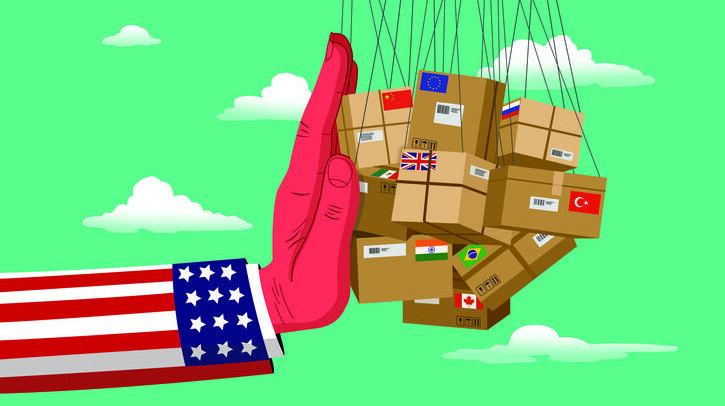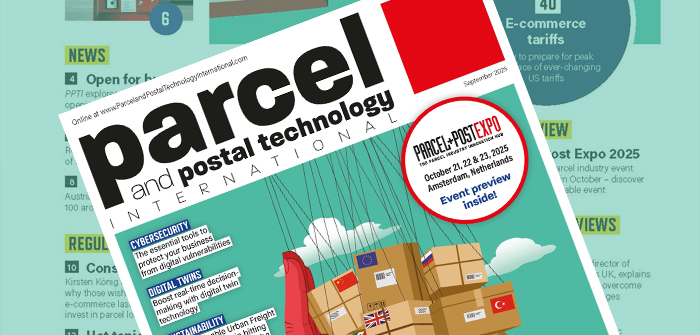President Trump’s tariffs announcement in April sent shock waves around the world, especially among e-commerce retailers and brands. Months on from that announcement, the lack of clarity about what, when and how – and even if the various proposed tariffs will apply by peak – has left many retailers struggling to understand how to prepare.
“There is still so much uncertainty surrounding how the new tariff regime is going to be implemented, and how it’s actually going to impact global trade, that it’s hard to plan,” says Bob Hoyler, global insight manager at Euromonitor International. “We’ve seen that as soon as President Trump announces a new tariff, he’s likely to immediately pause it, reverse it or threaten to increase it. So, at this time, the outlook on how tariffs are actually going to impact the retail e-commerce space is largely unknown.”
The confusion is frustrating but presents opportunities for logistics providers to become the guiding lights amid the turmoil, offering advice and practical solutions that will help retailers and brands navigate the uncertainties of transporting goods with minimal additional financial impact ahead of peak.
What’s happening?
Providing a definitive ‘what’s happening?’ isn’t easy, given the constant flux in tariff announcements. At the time of writing (the end of July), the most recent trade deal saw the EU and US agree to tariffs of 15% on imports from the EU, half the 30% tariff Trump had previously threatened to impose from the beginning of August.
Perhaps the most immediate impact on e-commerce has come as a result of Trump’s dealings with China, one of the main sources of goods for retailers and brands worldwide. Early May saw the US end the de minimis tariff exemption for goods valued under US$800 imported from China or Hong Kong, which previously could be shipped to the US without being subject to import duties. Shipments of such goods dived as a result. The Trump administration then announced an end to de minimis exemptions for all international parcels from August 29, 2025, unless they fall under a narrow exemption for personal gifts worth US$100 or less.
How to approach peak
Amid this uncertainty, retailers and brands must try to predict the impact such tariffs will have on their businesses and work out how to counteract it. For many, that includes reassessing their reliance on China. This affects many of the fastest-growing retailers of recent years, for whom sourcing goods from China to the US without added duties has fueled rapid growth.
“The retail sectors of both the US and China have been increasingly intertwined over the years, thanks to the rise of online marketplaces,” says Hoyler. On Amazon’s marketplace platform in February 2025, as many as half of the third-party merchants that sell into the US were located in China, he explains. “It’s been a core part of their business to utilize Chinese merchants and third-party sellers, to essentially do drop shipping right into the US,” he continues.
Similarly, the three fastest-growing online marketplaces operating in the US at the end of 2024 – Shein, Temu and TikTok Shop – are based in or originally from China. All are having to reevaluate their distribution business models.
Managing increased costs
Retailers have to decide how to manage the new costs they face from the additional levies now due at customs. “They have the hard decision of how much to hold back and impact their bottom line, versus how much to pass to the consumer and risk losing demand,” explains Rohit Tripathi, VP of industry strategy – manufacturing at supply chain planning platform Relex Solutions.
They also need to consider how potential price rises are communicated, according to Beth Chapman, managing director of Starlinks Global. “Retailers are rethinking everything – how they price, how they collect duty and how they explain it to customers,” she asserts.
Many are baking duty costs into their prices to avoid checkout friction. “Merchants are becoming very transparent and doing the fully loaded cost calculation when people are purchasing internationally from the US, so that buyers know what the full costs are,” notes Helaine Rich, ePost Global’s VP of strategic sales and administration.
While some are passing the costs on, others are absorbing them. This helps large-scale retailers, such as Amazon, build further scale but has a devastating impact on smaller e-commerce retailers. “Right now, there’s a unique opportunity for sellers because if you’re able to absorb the cost and keep your price at a relatively low level, that’s the kind of scenario that could afford a short-term opportunity to seize market share,” reports Euromonitor’s Hoyler.
Others are reassessing product portfolios or reengineering products to circumvent the tariff restrictions. “Retailers are making decisions on which product lines to continue or discontinue based on the tariff structures as the underlying cost increases are changing, including the shipment costs,” says Tripathi. He believes that ahead of peak, retailers have “little other option” than to simplify their product portfolios,
focusing on more profitable lines and addressing the demand for such items, rather than having everything available everywhere.
IMRG’s insights and strategy director Andy Mulcahy has witnessed the same: “If they sell into the US market and the items are manufactured in China, I know some retailers have just stopped listing those items,” he confirms.
Shifting focus to other markets
Another tactic is to shift focus for sales and manufacturing. Hoyler argues that this is already happening for the marketplaces most affected by the de minimis exemptions. “We’re seeing Temu and Shein rapidly expanding their presence across Europe, not just
in terms of their physical presence but also their advertising spend. Markets like Southeast Asia are also booming, but the challenge is that you can’t really replace the US as a market – it’s just too big,” he says.
Beibei Sun, head of Cainiao’s overseas supply chain – the logistics arm of Chinese Alibaba Group – is seeing a strategic shift as top sellers look beyond mainstream marketplaces for new growth. “There is a significant trend of expansion onto high-potential regional platforms, such as Mercado Libre in Latin America and Allegro in Europe, which offer enormous incremental sales,” she comments.
Planning orders
The uncertainty of when, where and how much stock retailers will sell as consumers begin to temper their demand in response to higher prices is affecting orders from retailers. That, in turn, is impacting supply.
Being prepared for peak to ensure retailers can avoid stockouts and lost sales, and protect against the fulfillment instability caused by the tariff uncertainty, is key.
This was hard enough with a softening economy pre-tariff announcement. “Retailers are hesitant about what to stock and from where, given the tariff negotiations as well as variability in global container shipments availability,” explains Tripathi. “This is leading to hesitation to place orders, causing wild swings in pricing, particularly for container shipping.”
In the UK, such challenges come on top of increased costs faced by carriers after government changes in April, according to IMRG’s Mulcahy. “As carriers tend to employ high numbers of staff on lower incomes [such as warehouse staff and drivers], those changes have obviously impacted them more than some other types of business, hence the price hikes,” he says.
Moving stock locally
A shift to localized inventory is by far the most significant change in response to the tariff announcements, according to Cainiao’s Sun. “Previously, many sellers relied on a direct shipping model [for example, shipping from China to a US consumer]. Now, they are proactively moving their inventory into overseas warehouses to operate on a local-to-local basis,” she explains. Cainiao’s global network of 40 overseas warehouses across the US, Europe and APAC helps enable this.
Holding more local inventory has two powerful benefits. “By shipping goods in bulk to overseas warehouses, retailers and brands manage customs and tariffs as a single, predictable, up-front cost, creating a crucial buffer against volatile trade policies,” Sun continues. “At the same time, this local stock is essential for meeting the stringent, fast delivery requirements of e-commerce platforms, ensuring sellers can offer the one- to three-day shipping speeds needed to boost visibility, satisfy customers and maintain a competitive edge.”
Many are choosing to warehouse in the US with bonded warehouses, where imported goods from China can be held without immediate payment of customs duties and tariffs until retailers are ready to sell, helping to better manage cash flow. There was an immediate uplift in demand for such space following the tariff announcements.
Yet the high costs of US warehousing and labor mean that this can also be challenging, and origin fulfillment still works well for many, according to Starlinks’ Chapman. “Moving stock stateside might reduce some duty costs but it adds other costs and complexity. It’s no silver bullet,” she warns. Others are looking at multicountry inventory strategies, helping to spread risk and products across multiple regions, and reducing exposure to individual country tariffs.
Careful consideration is required
The challenge is that any changes – such as where to manufacture, source or hold goods – require careful consideration, especially when it’s not even certain which tariff threats will stick before agreements are reached. “There’s always the chance that the tariffs might just get removed in a few months or drastically reduced, which might mean they don’t have to make all these switches,” says Mulcahy.
ePost Global’s Rich believes that ahead of peak, many companies are undertaking due diligence regarding what changes to make, rather than implementing knee-jerk reactions that could cost more than the tariffs themselves. “They’re not going to change their manufacturing or distribution centers prior to Black Friday, but they are looking at, for example, opening up facilities in the EU as a 2026 plan,” she notes.
“They’re going to monitor and watch what happens and be as nimble as they can to react to changes that may not be as much of an effort to adjust to as expected. They’re looking to see where it makes sense to open up a facility, what the labor cost would be and the different variables, and then making decisions on whether they should proceed with opening up additional hubs to make sure that the operating costs will make sense versus the additional tariffs.”
Logistics support
So, in this uncertain world, what role can logistics players play beyond the traditional services that they offer? Perhaps one of the most important opportunities is in providing the knowledge and support that retailers may lack regarding tariff implications.
“It’s a unique opportunity for logistics players right now, because their partners in the retail space are going to be relying very heavily on logistics players to sort out some of the new dynamics for them,” says Hoyler. “Logistics players are the experts in this because they’re doing this on a daily basis. They’re seeing how flows are transforming, and they’re going to be increasingly relied upon by their retail partners to be experts in terms of navigating these new waters.”
Chapman agrees that logistics players become a valuable resource amid the confusion. “The best providers aren’t just delivering parcels, they’re delivering clarity,” she explains. “Even enterprise clients come to us asking what these changes mean, never mind the TikTok startups scaling overnight without in-house expertise.”
The role of technology
Obviously, technology also helps with a range of solutions that meet challenges ranging from modeling the impact of cost increases to managing flow. “Software using AI capabilities can help retailers run multiple ‘what if?’ scenarios to evaluate their strategic options and investments, including trade-offs in pricing and promotions given the increase in input costs,” comments Tripathi.
One example is global logistics operator Maersk, which is actively supporting e-commerce customers in navigating tariff challenges through a combination of digital tools, customs expertise and flexible logistics services, according to Lars Karlsson, the company’s global head of trade and customs consulting.
In June, Maersk announced the use of AI within its Trade & Tariff Studio, a platform it says helps businesses manage tariff complexity. “It provides visibility into customs duties, taxes and regulatory requirements, and offers real-time updates from Maersk’s network of 2,700 customs experts,” Karlsson explains.
Peak will be more unpredictable than ever
Peak is rarely predictable for e-commerce retailers, and Trump’s tariffs make it harder than ever to judge potential volumes. Consumer spending is beginning to be affected, not just by the tariffs but also by other stock-market and geopolitical instability. Retailers will have to judge how the actions they take to mitigate the tariffs affect their sales, and whether they absorb the increase or pass it on to consumers.
“The consumer does pay,” says Chapman. “It’s just a question of whether they see it at checkout, at the door or buried in the price tag. Brands are walking a fine line between passing on costs and protecting conversion rates.” Logistics players can help minimize that impact.
Trump’s tariff threats
A 10% tariff on goods from China was one of Trump’s first moves on returning to power in February, and was doubled a month later. On April 2, Trump announced a range of global tariffs with a baseline of 10% across all imports, before pausing most of the country-specific tariffs a week later within hours of them going live.
At the same time, he raised the tariff on imports from China – the number-two provider of US imports, after Mexico – to 125% before a 90-day truce, after which he cut the tariff to 30%. In May, Trump threatened a 50% tariff on goods from the EU, scrapping these plans the next day. In July, he announced a 20% tariff on Vietnamese exports, while transshipments routed from third countries through Vietnam would face a 40% levy. In the same month, he threatened a 35% tariff on imports from Canada and a 30% tariff on imports from Mexico, although the latter was granted a 90-day reprieve on August 1.
On July 27, he agreed to a 15% tariff on imports from the EU into the US, half the 30% he’d threatened to impose from August. The following day, he threatened that most trading partners who didn’t negotiate separate trade deals would face tariffs of between 15% and 20%, and on July 30 he said the US would impose a 25% tariff on goods imported from India from August 1.
All information correct as of August 1, 2025
This article was originally published in the September 2025 issue of Parcel and Postal Technology International



